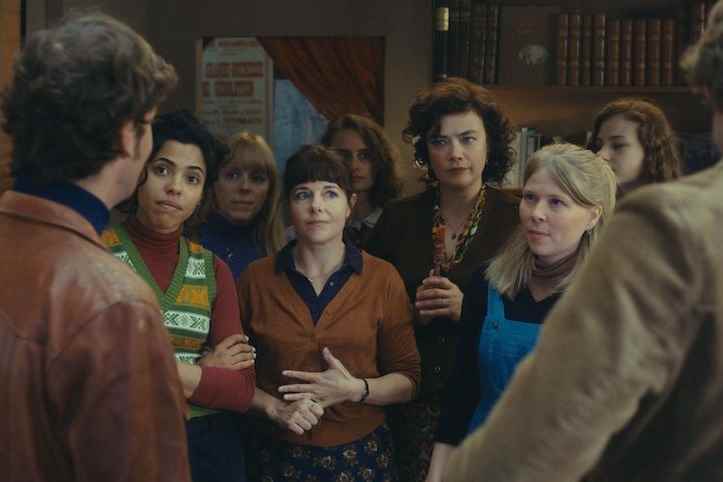(Paris) At a time when the right to abortion is today being questioned by ultraconservative movements in various countries, Annie Anger. This feature film by Blandine Lenoir recalls the struggles that women had to lead to get voluntary termination of pregnancy out of the law in the 1970s. Laure Calamy invested her whole being in it.
The story ofAnnie Anger takes place ten years after that of The event, this book by Annie Ernaux that Audrey Diwan brilliantly brought to the screen. When she presented her project to the financiers, Blandine Lenoir (Dawn) was told exactly the same thing as her colleague, namely that the question of the right to abortion was settled and that there was no need to go back. In other words, we wondered about the relevance of recounting today the actions of a movement that led the French government to decriminalize abortion in 1975, thanks to the famous Veil law.
“At the time we started thinking about this film, the right to abortion was not threatened as it is now”, remarks the filmmaker during an interview granted to The Press as part of the Unifrance French Cinema Meetings. “I had to explain to them that in France, there is also a lot of tension on this subject, even if we are not yet at the withdrawal of this right as in certain American states. This story is somewhat complementary to that of The event, insofar as it is because of what happened at the time of Annie Ernaux, at the beginning of the 1960s, that the militant movement that we evoke in our film was created. »
A militant fight
In Annie Anger, Laure Calamy lends her features to a worker, already the mother of two children, who accidentally becomes pregnant. In 1974, Annie met activists from the MLAC (Movement for the Freedom of Abortion and Contraception), within which abortions – illegal – were performed in complete safety in the eyes of all, with a view to benevolence and concrete help for women. Annie will be so enchanted – and overwhelmed – by her experience that she will find new meaning in her life by joining this group, which has only existed for 18 months.

PHOTO PROVIDED BY AXIA FILMS
Yannick Choirat and Laure Calamy in Annie Angera film by Blandine Lenoir
“By playing this character, I had the impression of telling an important story, confides Laure Calamy, also present during this meeting. My mother had already told me vaguely about this movement, without going into details. She said however how all this debate had shocked her. If the pressure from women had not been so strong at the time, I believe that the members of the government would never have passed the Veil law on their own. In any case, I was happy to have had the opportunity to deepen this important part of the history of women in France, now forgotten. »
A tailor-made role
Already winner of the César for best actress thanks to her performance in Antoinette in the Cevennes (Caroline Vignal), again in contention with Full time, by Quebecer Éric Gravel, Laure Calamy, for a rare time, was able to follow the evolution of a feature film from the writing stage. Blandine Lenoir, with whom the actress has already filmed twice (Zouzou And woman’s america), indeed wrote the role of Annie specifically for the one who was revealed to the general public thanks to the series Ten percent (call my agent).
“I believe that with this very reserved, very shy character, who is gradually taking her place, Blandine wanted to highlight a side of me that I do not give at all to see in life, indicates Laure Calamy. It’s not in my nature to be so reserved. Sometimes I even felt like I was inadequate. I’m usually reassured by the idea of being able to bring things out through a character, to exteriorize them. You can less get rid of your anxieties through an introverted character. That said, I really enjoyed being in the observation. This woman looks at what is happening all around, like a spectator. »

PHOTO PROVIDED BY AXIA FILMS
Laura Calamy in Annie Angera film by Blandine Lenoir
In its first versions, the script, very well documented, mainly focused on the activities of the MLAC with meetings, speeches, political actions. Gradually, the plot turned to more intimate aspects of the life of a mother, well supported by her husband (but how far?), who discovers solidarity and activism with other women.
“For me, it was exciting to see how the scenario evolved and was built, says Laure Calamy. This story is crossed by the notion of relief and turns out to be very luminous. Each woman is filmed very closely and exists very strongly, if only for a moment. It’s really beautiful. Although it has nothing to do with it, I see something in common with Pasolini’s cinema, with those shots on faces, where everyone exists in all their beauty and all their light. »
Tribute to Delphine Seyrig
Blandine Lenoir also wanted to include in her film a real scene from the archives, taken from a public affairs program broadcast at the time. We see the late Delphine Seyrig cut to pieces the arguments of men who, seated opposite her, vigorously oppose the legalization of abortion.
“I wanted to pay tribute to her, because she played a decisive role in this fight, explains the filmmaker. Delphine Seyrig also paid dearly for her commitment to the feminist struggle. The more she got involved, the less she was hired as an actress. I have always admired her. I would have loved to meet her so much! »
Annie Anger hits theaters February 10.
Travel expenses were paid by Unifrance.
